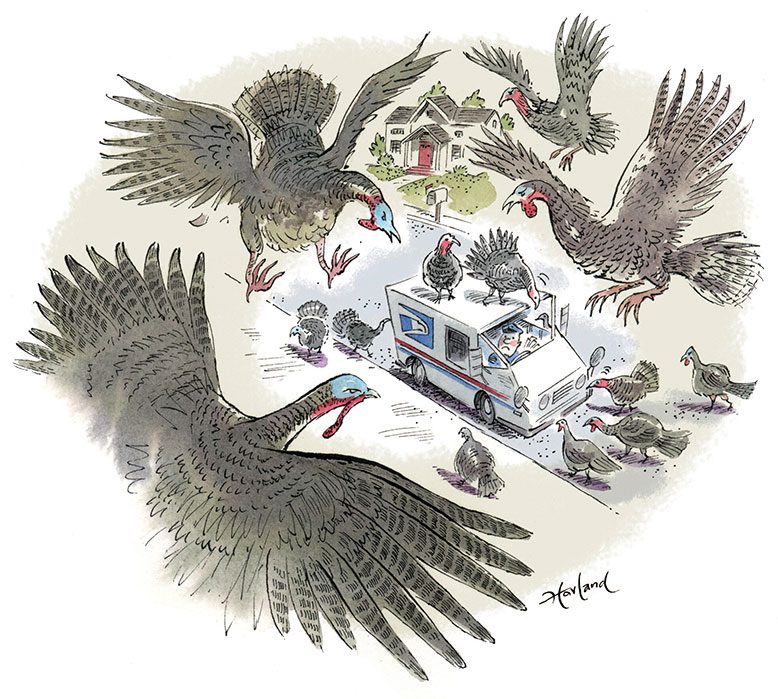
When I moved from Metuchen to Bloomfield, I expected higher taxes and more traffic. I did not anticipate turkeys gobbling at dawn—a sound akin to an opera singer gargling.
It turned out they were wild turkeys, and I was elated. Every neighborhood has birds, squirrels, maybe even a skunk or a raccoon. But turkeys were a new highlight to look forward to on my morning walks. Some days, they looked splendid, with the sunrise illuminating their feathers. Other times, they seemed prehistoric, standing on taloned toes with a kickstand-type appendage at the back of their legs.
The turkeys never bothered me when I was on foot, but driving was a different story. When I slowed to gawk at them, one or more would come at my car and even begin pecking at the tires or metal.
Curious about these creatures, I contacted Lou Gambale, president of the New Jersey chapter of the National Wild Turkey Federation. Turkeys, he explained, might charge a car because they’re territorial, especially males during breeding season (roughly March through June, depending on the weather). “They’re not playing with a full deck that time of year,” Gambale told me.
In 1977, biologists from the state Division of Fish and Wildlife worked with a group of volunteers to reintroduce Eastern turkeys, which had disappeared from the Garden State by the mid-1800s. Now the division estimates there are 25,000 wild turkeys in New Jersey. The population today, said Gambale, is slightly on the rise in North Jersey and stable in South Jersey.
Turkeys are omnivorous. They eat nuts, leaves, seeds, berries, insects and salamanders. In the wild, they can live three to five years. Eggs are in nests on the ground, vulnerable to skunks, raccoon, possums and snakes. Four weeks after hatching, poults can’t fly up to roost, putting them at risk of falling victim to feral cats, dogs, coyotes, as well as excessive cold. Adults can fall prey to foxes, coyotes, red-tail hawks and great-horned owls.
Development is also a threat; as turkeys lose habitat, they spread to densely populated areas, roaming parks and backyards in search of food. Hunters are another hazard. New Jersey has two turkey-hunting seasons: five weeks starting in April when males can be hunted, and one week in early November when any turkey can be killed.
In Bloomfield, not everyone is a fan. The neighborhood Rottweiler is afraid of turkeys, yet a yappy little pup is ready to challenge the big birds on any given walk. A neighbor complained the turkeys pooped all over the place.
Still, I was enthralled. The turkeys—up to a dozen at a time—slept in a tree fewer than two blocks from my home. Gambale told me the birds routinely fly 25 to 30 feet high and as fast as 55 miles per hour. Once aloft, turkeys can glide up to 200 yards before landing.
Despite their natural talents, turkeys have a way of making trouble. Last year, a mail carrier called Hillsdale police when a turkeys swarmed his truck. In Teaneck, a turkey crashed through a kitchen window, spraying glass and disrupting dinner. The state Division of Fish and Wildlife responds to about 20 to 30 incidents annually of turkeys behaving badly.
It gives me pause. Maybe my neighborhood isn’t as special as I thought. Maybe turkeys are just another fact of New Jersey life.
Sharon Waters is a freelance writer in Bloomfield.




We had them in West Orange, and now that we have moved to Manchester in Ocean County, we still have them.
In Upper Saddle River for years. They hated my husband’s car/tires and slept on the roof of my next door neighbor.